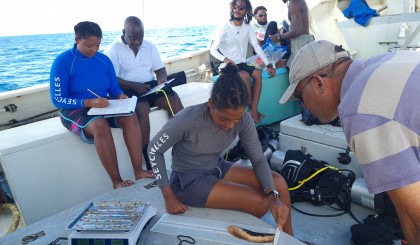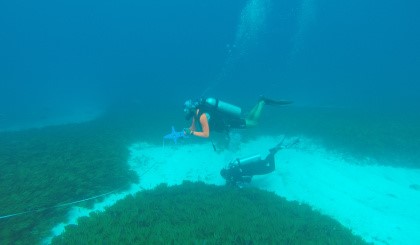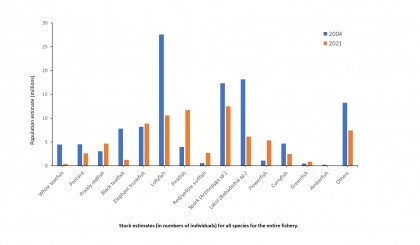Seychelles sea cucumber survey 2021/22 |30 January 2023
Seychelles Nation
‘Sea cucumber fishery is at an important crossroads’
The Seychelles sea cucumber fishery is at an important crossroads where some species appear to be somewhat resilient to heavy fishing pressure while there are clear signs of over-exploitation.
This finding comes in the final report on the 2021/22 sea cucumber stock assessment field survey by the Seychelles Fishing Authority (SFA) which has officially been published.
The field survey was carried out with participants from the commercial fishing industry; and Tim Skewes Consulting provided sample design, data analysis and management recommendations.
The main objectives of the project were to conduct a fisheries independent survey to assess the abundance of all sea cucumber resources; provide information on the stock status of the main commercial species; collect biological and ecological information on sea cucumber species; understand the effect of exploitation on sea cucumber population and distribution, and; provide management advice to guide the future management of the sea cucumber fishery.
In 2004, the first full-scale stock survey for the fishery was carried out and included a survey of 246 sites throughout the Amirantes and Mahé Plateau. This 2021-22 survey used standard survey and stratified analysis techniques to gather and analyze the data. It was designed to revisit about 200 of the original sites surveyed in 2004, to estimate the trends in density and population size since that time.
Uniquely, the survey included commercial divers who participated in dive transects and video observations.
Scientific and commercial divers both saw about the same number of sea cucumbers during the diver surveys.
An additional survey on a restricted area of the Mahé Plateau was also carried out in 2011 (Koike, 2017), and data from that survey was also used to assess stock status.
The main challenge that the team faced were related to the sea conditions, where at times they had to deal with poor visibility and/or high currents, which led to 14 sites being abandoned.
However, the team still managed to visit 206 (out of the planned 220) sites, a remarkable achievement given the scope of work.
From the analyses performed, the data collected on White Teatfish all points to a heavily depleted population, to approximately 10% of its 2004 level, and highly likely to be below the level of recruitment impairment. The Pentard population may have been reduced by about half since 2004. While Prickly redfish saw an increase of 52% on the 2004 estimate, the population estimate for Black teatfish indicates a decline of 84% from the 2004 estimate. The results for the population estimates comparatively with the survey of 2004 for various sea cucumber species can be seen in the Stock Estimate graph.
Prior to the publication of this report and as part of the project, a public validation workshop was held in September 2022, where stakeholders and the general public were invited and presented with the initial findings, with the aim of collecting feedback and comments on the assessment and results. Many questions arose in regard to how the survey was conducted, especially in terms of site selection relative to where the local fishers/divers fish for sea cucumber. The audience was reminded that surveys needs to be random or else there will be biases in the data. Additionally, education between fisher and scientist was highlighted as an important aspect to understanding the methodology. Suggestions were brought forward for more frequent surveys, more proactive engagement by the authority with stakeholders, participation of stakeholders in policy decisions and review in survey methods. The department of Environment as the authority for convention on international trade in endangered species (which includes sea cucumber species) recommended that SFA engages with them in the beginning of the process for the management of sea cucumber species, so that they can also provide guidance.
When submitting the final report, the survey consultant, Mr. Timothy Skewes said that
“The Seychelles sea cucumber fishery can provide significant economic benefits to current and future generations or Seychellois. However, the fishery is at an important crossroads. It has fished hard for several years and many species are now showing signs of being over-fished, including the prized Pentard. Industry, management, and scientists need to work together to ensure the long-term survival of the fishery. There is increasing scrutiny on sea cucumber fisheries globally. If the Seychelles sea cucumber fishery can act and implement sustainable fishing practices, then access to global markets will remain open, and possibly at a premium given the Seychelles growing reputation for environmental stewardship.”
The final report includes several recommendations from Mr Skewes including the implementation of a multispecies fishery harvest strategy for sea cucumber fishery, monitoring, production of a comprehensive fishery species ID guide, quota reduction and in the case of White Teatfish, to cease fishing and monitor in 3 years. The full list of recommendations can be found in the final published report.
The Head of the SFA Fisheries Research department, Rodney Govinden said “The research had for the first time seen the participation of industry divers in the implementation of the surveys. This is an important step towards co-management and the continuous improvement in the future management of the fishery.”
The sea cucumber fishery season 2022/2023 was opened from October 15, 2022 and will close on June 25, 2023, where 25 licenses have been allocated to local fishers. Only three sea cucumber species are allowed to be fished per licensed vessel within the authorized zones, with the following quotas;
Flower Teat Fish “Pentard” – Quota = 9619 (5% decrease from previous season, originally 10125)
Golden Sandfish “Kokonm” – Quota = 4000 (new species introduced this season)
Prickly Redfish “Sanpye” – Quota = 1800 (20% increase from previous season, originally 1500).
A copy of the report can be downloaded from the SFA website through the following link:
https://www.sfa.sc/index.php/e-library/fisheries-report/category/43-stock-assessment-reports
Press release from the SFA




Leave A Comment